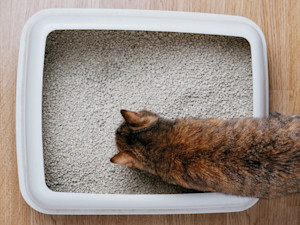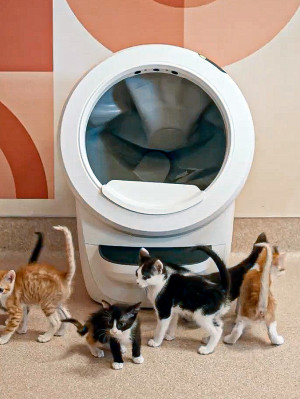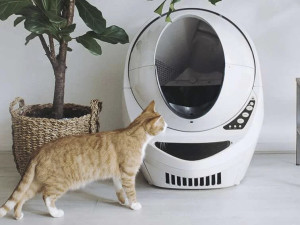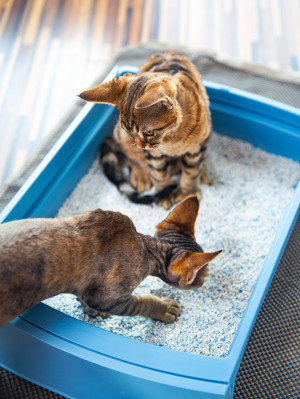10 Reasons Why Your Cat Isn’t Using the Litter Tray
Not on the couch... again
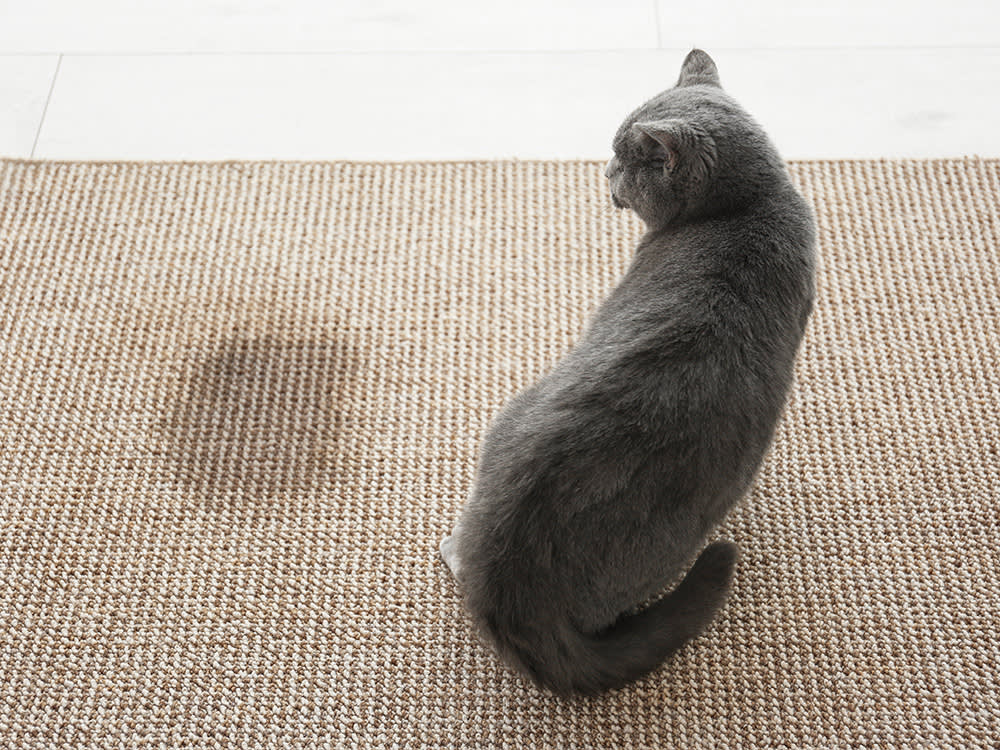
Share Article
It can be frustrating and a little puzzling when a once perfectly house-trained cat suddenly starts avoiding their litter tray. Whether they're leaving surprises on the carpet or choosing a quiet corner instead, it’s often a sign that something isn’t quite right in their world.
From medical conditions and stress, to picky preferences or environmental changes, there are many reasons why a cat might snub their litter box. Understanding the root cause is key to resolving the issue and getting your feline friend back on track and back in the box. Try not to worry too much: as a veterinary nurse and a feline behaviour advocate, this is one of the most common topics I have to help cat parents with. In this article, I’ll unpick the reasons why your cat’s gone rogue, before discussing options that could help.
Before playing cat detective, a full health check by your veterinary surgeon is vital to rule out any problems. We then need to consider if any stressors may have developed within your cat’s territory which may be causing stress and upset. Health, litter tray preference, age, environmental changes, stress and marking behaviours are our main factors to investigate.
Medical problems
Medical issues are a really important (and often-overlooked) cause of litter tray avoidance. Here are the most common ones to watch out for:
Urinary tract infections
Any medical condition that involves the bladder can be painful whether that’s with a UTI (urinary tract infection), bladder stones or FIC (feline idiopathic cystitis). Sadly, the pain that comes with the condition can mean your cat may associate their tray with the pain and therefore choose to go somewhere safer and more comforting...like on your duvet.
Kidney disease
When a cat starts to develop kidney disease it will make them drink more and therefore urinate more. This may lead to accidents as they are not able to visit the tray in time or manoeuvre around the obstacles in the way of the tray. The increase in urine will also mean their tray gets more soiled – and who wants to revisit a dirty toilet?
Arthritis
As cats age they can develop joint problems which may make visiting the tray more of a challenge as they navigate pain and a reduced range of movement in their joints.
Digestive problems
Constipation or diarrhoea can lead to pain or an increased frequency of needing the toilet which may also lead to a change in behaviour.
Stress or anxiety
As well as being picky about their toilet arrangements, change or stress within their immediate environment can lead to anxiety and frustration. This may lead your cat to avoiding the tray altogether or needing to show another cat they are present within the territory by marking their territory – again, on your duvet.
Environmental and behavioural reasons
If a medical condition has been ruled out, then we need to look at other reasons why your cat’s behaviour has changed. Some immediate things to consider would be:
Physical changes in the home
Cats can be sensitive to change. Triggers might include: moving house or rearranging of furniture, decorating, loud noises (such as fireworks or DIY). Some cats will urinate outside the box as a way to mark territory or self-soothe.
New pets or family members
Cats can feel overwhelmed or insecure with the sudden change in scents and noise levels that an additional family member; however many legs they have, can bring into the home. Cats are creatures of habit and highly sensitive to changes in their environment. When a new pet or person enters the household, it can trigger stress, anxiety or even territorial behaviour.
Changes in routine
Cats, like many animals (and humans!), thrive on routine which helps to make them feel safe and secure. If this is disrupted it can lead to stress, confusion and anxiety. If you are suddenly around more or less than usual this could lead to separation problems. Although we commonly hear about separation anxiety in dogs, cats too may not be able to cope if their owners suddenly withdraw their attention.
Not enough litter trays
The golden rule of one litter tray per cat plus one extra is vital especially in multi-cat households – yep, even in your teeny, tiny flat (sorry). Too few trays can cause territorial issues as well as resource guarding. If a tray is being visited frequently it also will get dirty quicker. Cats are known for being clean and so they expect their toilet to be, too.
Wrong type of litter
If we consider that cats’ ancestors are from the desert and they used sand as their litter, it makes sense that cats have an instinctive preference for more finely-grained litter material. They also have very sensitive paws and finer grained material is less likely to cause discomfort.
How to get your cat to use the litter tray again
Make sure you’ve considered all of the following:
Cleanliness: just as we like a clean toilet, so do our cats. Some cats may not revisit the tray if they have already used it. Some may not want to defecate where they have urinated so this should be considered when choosing the number of trays.
Scented litter: cats hate strong smells and so scented litters or deodorisers can be off-putting to some cats.
Wrong type of litter: texture matters; finer grained clumping types can be easier to manage. Switching brands can sometimes throw your cat off so ensure you mix the old with the new or even offer a new tray if you‘re trying out a new one.
Depth: a 3–5cm depth is considered ideal. Also, litter liners can sometimes interrupt the digging that is a part of their natural toileting behaviour. Cats will not enjoy their claws getting caught.
Too small or overly enclosed: often, litter trays are too small. What may have been fine as a kitten, might now be too small for your adult cat. A tray ideally should be one-and-a-half times the length of the cat from the nose to the base of the tail. Some cats prefer open trays over covered ones for fear of being ambushed (don’t you enjoy a lock on your toilet door?). However it is important that because a litter tray is enclosed, you don’t forget to empty it. Think festival toilets on the Sunday night.
Too few trays: the rule of thumb is one tray per cat plus one extra, and these trays should be in separate areas, not all next to each other. If the trays are side by side, a cat will only see it as one toilet option.
Tray placement: cats want a quiet, private and safe spot to do their business. If the tray is in a noisy area (near washing machines, busy hallways, etc) or somewhere they feel trapped, they might avoid it.
Ease of access: especially important if you cat is recovering from UTI or may have stiff joints caused by arthritis of general ageing. Hopping into a tray with a higher entrance might no longer be possible for them.
How to design the optimal litter tray
So, what’s the perfect litter tray?
Size: at least one-and-a-half times the length of a cat from nose to tail.
High sides: to help keep the litter in the tray. Ensure there is a low side for kittens and older cats to get into.
Type of litter: ideally unscented, fine-grain clumping litter, which is easier to scoop and keep clean.
Number: one tray per cat, plus one extra.
Location: place trays in quiet, low-traffic areas where your cat feels safe. Avoid putting them near food and water bowls – cats like to keep those areas separate. Steer clear of loud appliances (like washing machines) or areas that are hard to reach.
Hygiene: scoop out twice daily, clean the whole tray weekly. Some cats will refuse to use a tray that isn’t clean. Strong chemical cleaners leave behind smells cats don’t like so use mild, unscented soap or enzyme cleaners.
Bottom line: why your cat is not using the litter tray
If a cat is avoiding the litter tray and there’s no obvious change in their environment or litter setup, a vet check-up is essential especially if they’re showing any signs of discomfort, straining or changes in appetite, weight or behaviour.
Frequently asked questions about cats not using litter trays
How do I fix my cat not using the litter box?
Ensure that you have had them checked by a vet to rule out any underlying medical issues and also look at your litter tray setup. Cats can be surprisingly particular about where and how they do their business. To encourage consistent litter tray use, focus on comfort, cleanliness and accessibility
Why won’t my cat go in the litter tray?
Your cat might be avoiding the litter tray due to stress, illness, a dirty box or simply not liking the setup. It’s their way of saying something’s wrong. And it’s worth listening to them!
Why is my cat not using the litter box suddenly?
If this is a sudden change in behaviour then it may be something simple like a change in litter type or the tray has been moved or access blocked. However, if it becomes a persistent problem then further investigations need to start with the cat and the environment.
Resources
“Understand Normal Feline Behavioursopens in new tab (2019).” The Royal (Dick) School of Veterinary Medicine, University of Edinburgh.
Heath, S., and Halls,V., “Treatment in Cases of Feline House Soiling.opens in new tab” The Veterinary Nurse, 2 Oct. 2015.
Carney, Hazel C., et al. “AAFP and ISFM Guidelines for Diagnosing and Solving House-Soiling Behavior in Cats.opens in new tab” Journal of Feline Medicine and Surgery, vol. 16, no. 7, June 2014, pp. 579–98.
Guy, Norma C., et al. “Litterbox Size Preference in Domestic Cats (Felis Catus).opens in new tab” Journal of Veterinary Behavior, vol. 9, no. 2, Mar. 2014, pp. 78–82.

Zoe Blake RVN, ISFMCertFN / AdvCertFB, MISAP
Zoe is a registered veterinary nurse and has been in the profession for over 30 years. She enjoys educating pet owners on all aspects of their care and regularly writes to support her work. When she is not chatting animals, she can be found running around the tennis court or exploring the countryside with her rescue dog, Dylan.
Related articles
![Birds Eye view of a cat on the edge of a litter tray]()
Yes, You Can Train an Older Cat to Use a Litter Tray
No more accidents here
![Kittens and the Litter Robot kitty litter box.]()
The Best Litter Boxes for Kittens in 2024
Help your little one learn the ropes
![Maine coon cat using the litter box.]()
What is Tofu Cat Litter?
Spoiler alert: it’s not an ingredient for your next vegan dish
![A cat walking by a little box]()
Litter Robot: Will My Cat Use an Automatic Litter Box?
I introduced my cat to an automatic litter box, and let’s just say it went off with... multiple hitches
![Maine coon cat using the litter box.]()
Uncovered Secrets: Why Cats Don’t Always Cover Their Poo
And how you can encourage them to cover up after doing their business
![two cats sharing litter box]()
Can Cats Share a Litter Box?
The better question is should they?

